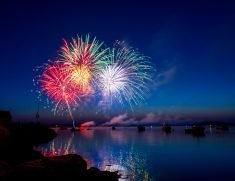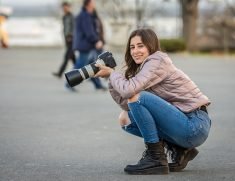Last updated on December 5th, 2023
Hockey is a fast-paced and exciting sport that can be challenging to capture through photography. Whether you’re shooting a local game or an NHL matchup, there are several factors to consider when photographing hockey. In this blog post, we’ll cover the best camera gear, settings, and techniques for shooting hockey photography, as well as some tips and tricks to help you get the best shots possible.

Camera Gear for Hockey Photography
Choosing the right camera gear is essential for capturing great hockey photos. You need equipment that can handle the game’s fast pace and low-light conditions. Here are some recommendations for camera gear:
Camera Body Recommendations
For shooting hockey, you will need a camera with a fast autofocus system, high ISO performance, and a fast continuous shooting speed. A high-end camera such as the Nikon D6 or Canon EOS 1D X Mark III is ideal.
These cameras have a fast and accurate autofocus system, high ISO performance, and a fast continuous shooting speed, which is essential for capturing the fast-paced action of hockey.
Lens Recommendations
Your chosen lens will also play a significant role in your hockey photography. The 70-200mm f/2.8 zoom lens is the most popular shooting hockey lens. This lens allows you to capture various shots, including close-ups of players and wide shots of the rink.
Other recommended lenses include the 100-400mm zoom and 300mm prime lenses. The 100-400mm lens is ideal for shooting from a distance. In contrast, the 300mm prime lens provides sharper images and faster autofocus performance.
Other Equipment to Consider
When shooting hockey, a few other pieces of equipment can help you capture incredible photos. A monopod or tripod can help stabilize your camera and reduce camera shake. A fast memory card is essential for shooting continuous bursts of photos. You should also carry extra batteries, lens cleaning supplies, and rain covers to protect your gear from the elements.

Camera Settings for Hockey Photography
You need to have the correct camera settings to capture great hockey photos. Here are some recommended settings for shooting hockey:
Shutter Speed
Hockey is fast-paced, and you need a fast shutter speed to freeze the action. A shutter speed of at least 1/1000th of a second is recommended. You may need to go even faster if the players move particularly fast. A fast shutter speed will help you capture sharp images of the players and the puck.
Aperture
Your aperture will depend on the distance between you and the subject you are shooting. If you shoot close-up shots of the players, you should use a wider aperture, such as f/2.8. This will help you isolate the subject and blur the background. If you are shooting from a distance, you should use a smaller aperture, such as f/5.6 or f/8, to ensure that everything is focused.
ISO
Hockey is often played in low light conditions, so you must use a high ISO to get the correct exposure. However, using a high ISO can introduce noise into your photos. It’s a balancing act between getting the correct exposure and minimizing the noise. A full-frame camera such as the Nikon D6 or Canon EOS 1D X Mark III can handle high ISOs better than a crop sensor camera.
Focus Settings
You need to use the correct focus settings to capture sharp images of the players. For hockey, you should use continuous autofocus (AF-C) mode to track the players as they move around the rink. You should also use the center autofocus point, which is the most accurate and the fastest.
White Balance
You should manually set your white balance to get accurate colors in your photos. If you shoot in an indoor arena, the lighting can be challenging to get the white balance right. You can use a gray card or a white sheet of paper to set the white balance manually. If you shoot in RAW format, you can adjust the white balance during post-processing.
Shoot in RAW
Shooting in RAW versus JPEG format is highly recommended for hockey photography. RAW files contain all the data captured by the camera’s sensor, which gives you more flexibility and control when editing your photos.
RAW files also have a more comprehensive dynamic range and more color information than JPEG files, which can help you recover highlights and shadows and improve the overall look of your photos. However, RAW files take up more space on your memory card and require more processing power and editing time. But with better image quality and flexibility benefits, shooting in RAW is worth considering for hockey photography.

Shooting a Hockey Game
Now that your camera gear and settings are sorted out, it’s time to start shooting. Here are some tips for shooting a hockey game:
Getting to the Game Early and Scouting the Arena
Arriving early at the arena will give you time to scout the best positions to shoot from. You can also familiarize yourself with the lighting conditions and the players’ movements. It’s also good to talk to the other photographers and see where they will be shooting from.
Positioning Yourself for the Best Shots
When shooting hockey, you should position yourself where you can see the action and get the best shots. It would help if you tried to shoot from different angles and positions, such as from behind the goal, along the boards, or from the penalty box. Shooting from different angles will provide variety to your shots.
Anticipating the Action and Capturing Key Moments
Hockey is a fast-paced game; you must anticipate the action to capture the best shots. Try to predict where the players will be moving and where the puck will be going next. It would help if you also tried to capture the game’s critical moments, such as a goal celebration or a body check.
Using Different Shooting Modes and Techniques
To capture various shots, you should use different shooting modes and techniques. Burst mode can help you capture multiple shots of the exact moment. You can also use panning to capture the players’ movement and create motion blur. Another technique is to use a slower shutter speed to capture the players’ movements and create a sense of motion.

Tips and Tricks for Hockey Photography
Here are some tips and tricks to help you capture great hockey photos:
Using Burst Mode to Capture Multiple Shots
Using burst mode can help you capture multiple shots of the exact moment. This can be helpful when trying to capture the perfect shot of a goal celebration or a body check. However, be mindful of your memory card space and delete unwanted shots.
Using Image Stabilization for Handheld Shots
Image stabilization can help you capture sharp images when shooting handheld. If your lens has image stabilization, make sure to turn it on. If your camera body has image stabilization, turn it off when using a stabilized lens.
Keeping the Camera Level and Avoiding the Boards
When shooting along the boards, make sure to keep your camera level. Tilting your camera can distort the players’ bodies and the rink. You should also avoid getting too close to the boards, as you can get hit by a puck or a player.
Anticipating the Players’ Movements and Reactions
Hockey players move fast; you must anticipate their movements to capture the best shots. Try to predict where the players will be moving and where the puck will be going next. It would be best if you also tried to capture the players’ reactions to the game, such as their facial expressions and body language.
Shooting During Warmups and Intermissions
Warmups and intermissions can provide excellent opportunities for shooting hockey photos. During warmups, the players are more relaxed and may interact with the crowd. During intermissions, the arena may be less crowded, allowing you to move around more freely.

Post-Processing Hockey Photos
Once you have finished shooting, it’s time to edit and post-process your photos. Here are some tips for post-processing hockey photos:
Importing and Organizing Your Photos
Import your photos into your favorite editing software and organize them by game or period. This will make it easier to find specific shots later on.
Editing Your Photos in Lightroom or Photoshop
You should adjust the exposure, contrast, and color balance when editing your photos. You can also crop your photos to improve the composition. If your photos have noise, you can use noise reduction tools to reduce the noise.
Cropping and Adjusting Exposure
Cropping your photos can help you improve the composition and focus on the subject. You can also adjust the exposure, contrast, and color balance to improve the overall look of your photos. Be careful not to over-edit your photos, making them look unnatural.
Exporting and Sharing Your Photos
Once you have finished editing your photos, you can export them in different formats and sizes. You can also share your photos on social media, your website, or with the team or players you photographed. Remember to credit the players and the team, and follow copyright or usage guidelines.
Conclusion: How to Photograph Hockey
Hockey photography is a challenging and exciting genre of sports photography. It would help to have the right camera gear, settings, and techniques to capture great hockey photos. You should also be patient, anticipate the action, and experiment with different angles and positions. You can capture fantastic hockey photos that impress your friends, family, and clients with practice and persistence.


